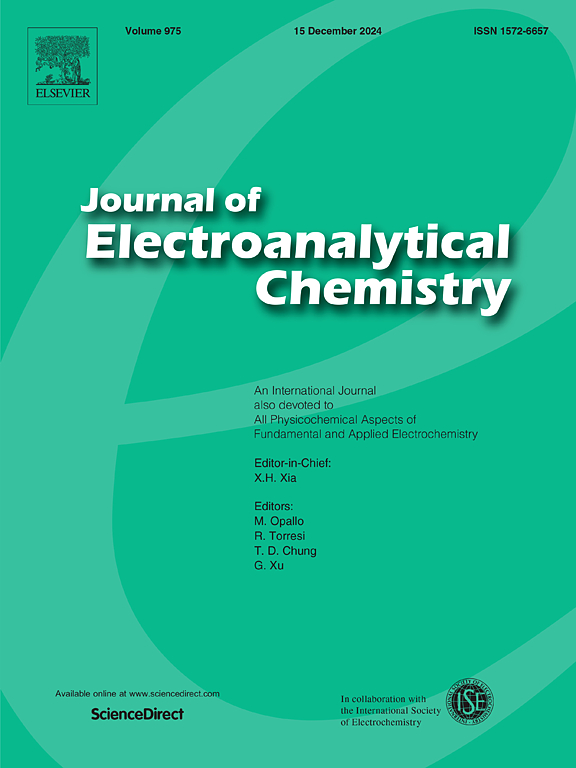紫外辅助电化学氧化处理含盐废水:条件优化及机理探讨
IF 4.1
3区 化学
Q1 CHEMISTRY, ANALYTICAL
引用次数: 0
摘要
各种工业过程产生的含盐废水对环境构成重大挑战,如果处理不当,会导致宝贵的含盐资源浪费。传统的处理方法往往不能有效去除含盐废水中的有机污染物。本研究采用紫外辅助电化学氧化(UV/EO)工艺对含盐废水中的苯酚进行了有效降解。系统地论证了紫外辐照与电化学氧化对苯酚降解的协同作用。通过电子顺磁共振(EPR)分析和活性自由基稳态浓度的测定,对UV/EO过程的机理有了深入的了解。此外,采用气相色谱-质谱(GC-MS)和高效液相色谱(HPLC)对苯酚降解中间体进行了鉴定。通过自由基抑制实验进一步研究了这些中间体在UV/EO体系中的降解途径。结果表明,UV/EO过程表现出明显的协同效应,主要是由于紫外线照射下羟基自由基(OH·)的生成增强。此外,还利用含复杂难降解有机污染物的含盐工业废水对UV/EO系统的性能进行了评价。在最佳条件下,UV/EO体系对TOC的去除率为68.9%,比单独使用EO工艺的56.5%高出12.3%。该研究为UV/EO工艺的机理提供了更深入的理解,并强调了其在处理含盐有机废水中的实际应用潜力。本文章由计算机程序翻译,如有差异,请以英文原文为准。

UV-assisted electrochemical oxidation for saline wastewater treatment: Condition optimization and mechanism exploration
Saline wastewater, generated from various industrial processes, poses significant environmental challenges and leads to the waste of valuable saline resources if not properly treated. Traditional treatment methods often fail to achieve efficient removal of organic pollutants in saline wastewater. In this study, a UV-assisted electrochemical oxidation (UV/EO) process was employed to effectively degrade phenol in saline wastewater. The synergistic effects between UV irradiation and electrochemical oxidation (EO) on phenol degradation were systematically demonstrated. Mechanistic insights into the UV/EO process were provided through electron paramagnetic resonance (EPR) analysis and the determination of steady-state concentrations of reactive free radicals. Additionally, the phenol degradation intermediates were identified using gas chromatography–mass spectrometry (GC–MS) and high-performance liquid chromatography (HPLC). The degradation pathways of these intermediates in the UV/EO system were further investigated through free radical inhibition assays. The results revealed that the UV/EO process exhibited a significant synergistic effect, primarily due to the enhanced generation of hydroxyl radicals (OH·) under UV irradiation. Furthermore, the performance of the UV/EO system was evaluated using real saline industrial wastewater containing complex and refractory organic pollutants. Under optimal conditions, the UV/EO system achieved a TOC removal rate of 68.9 %, which was 12.3 % higher than the 56.5 % achieved by the EO process alone. This study provides a deeper understanding of the mechanisms underpinning the UV/EO process and highlights its potential for practical applications in treating saline organic wastewater.
求助全文
通过发布文献求助,成功后即可免费获取论文全文。
去求助
来源期刊
CiteScore
7.80
自引率
6.70%
发文量
912
审稿时长
2.4 months
期刊介绍:
The Journal of Electroanalytical Chemistry is the foremost international journal devoted to the interdisciplinary subject of electrochemistry in all its aspects, theoretical as well as applied.
Electrochemistry is a wide ranging area that is in a state of continuous evolution. Rather than compiling a long list of topics covered by the Journal, the editors would like to draw particular attention to the key issues of novelty, topicality and quality. Papers should present new and interesting electrochemical science in a way that is accessible to the reader. The presentation and discussion should be at a level that is consistent with the international status of the Journal. Reports describing the application of well-established techniques to problems that are essentially technical will not be accepted. Similarly, papers that report observations but fail to provide adequate interpretation will be rejected by the Editors. Papers dealing with technical electrochemistry should be submitted to other specialist journals unless the authors can show that their work provides substantially new insights into electrochemical processes.

 求助内容:
求助内容: 应助结果提醒方式:
应助结果提醒方式:


